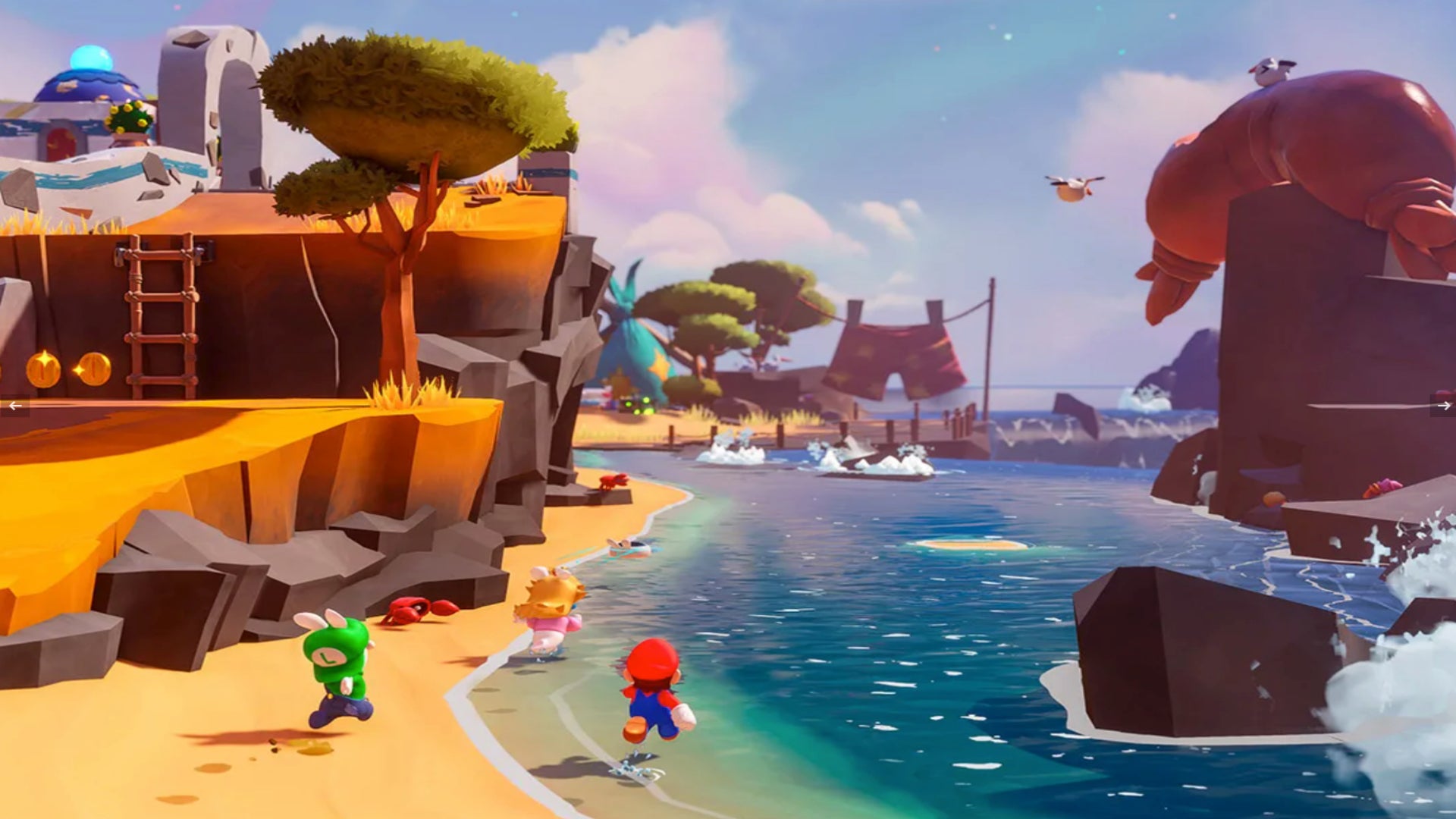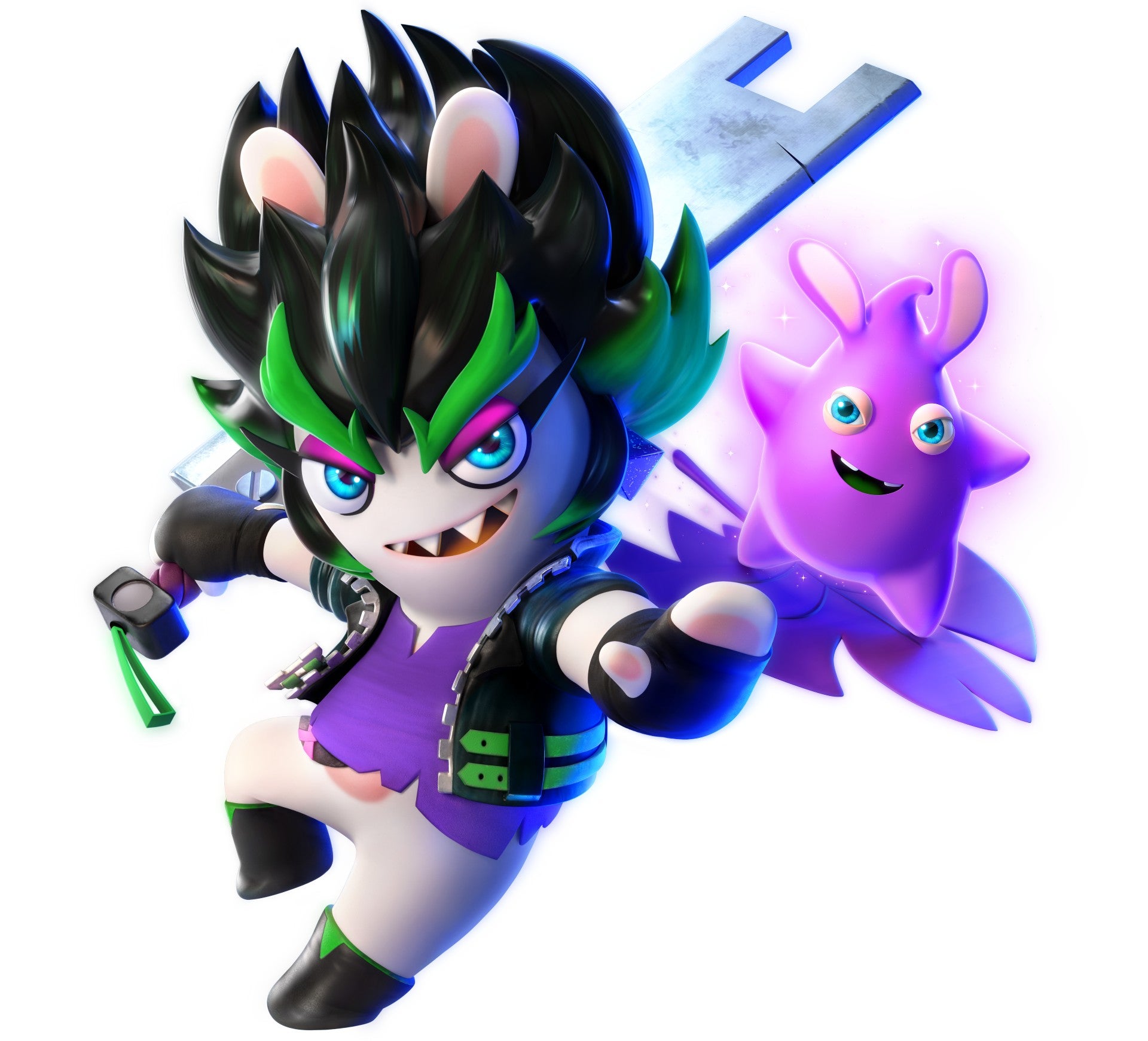Mario + Rabbids essentially showed us what a world of rabbid Mario characters would look and behave like (two bs! Although rabid Mario characters is a spin-off I’d play). The game saw these alternate, often hilarious creatures, fighting alongside the OG Mario, Peach, Luigi and the rest, firing unique weapons and teaming up to perform special attacks. This is all true in Sparks of Hope, except now the peace brought about at the end of the first game is rocked by a new enemy: Cursa. This being is blighting the worlds with darkmess (looks a lot like ink) and draining the sparks of their energy. As is the Mario + Rabbids way, sparks are the rabbid version of lumas, the lovely creatures from Mario Galaxy. In Sparks of Hope they provide Spark powers, which help you offensively and defensively during battles.
Part turn-based tactical combat, part semi-open world adventure, my fondness for Sparks of Hope crept up on me. Its characters, a mix of Mario stalwarts and a bizarre mix of rabbids (the things that spun out of Ubisoft’s Rayman series) are all charming; the world design feels like a mix of children’s TV show and Nintendo vibes; and the learning curve is spot-on, nailing the intro and then introducing more challenge without sudden spikes. But there’s a harshness to proceedings, sort of hanging in the air like the zestiness of an orange. It’s sharp, but rather pleasant. Yes, a rabbid will joke around in a cutscene that wouldn’t be out of place in a Lego game – but moments later your team is getting absolutely owned by a bunch of nobody enemies who think they’re hot shit.
Mario + Rabbids Kingdom Battle set things up well back in 2017, but despite some smart gameplay design choices the overall experience was still more or less in line with what you might expect from a turn-based tactics game in the classic X-COM mold. There was a movement grid, character movement lines, and the whole game world was designed to allow for tactics-based combat. Sparks of Hope takes the lighthearted fun of that game, introduces game worlds designed to be explored instead of fought in, and takes all combat into arenas, a bit like what happens when you battle in the original Final Fantasy 7. For the most part you choose to go into battle, but occasionally while exploring an enemy will run into you and propel you into action – but you can choose to flee the fight if you wish.
This change to how the explorable worlds are designed is, for my golden coins, a masterstroke. Sparks of Hope is instantly more welcoming to newcomers to the genre, and the changes don’t stop there. Combat itself is far more fluid than we had before. Each character in your party (the number and options change as you move through the game) is free to move within a set area as much as they like until they fire their main weapon or run out of action points. Enemy-targeting is still handled by selecting the foe you want to aim at, and you’ll need to pay attention to the cover you leave your characters in before the enemies take their turn, but the whole thing feel less rigid, which is never a term that should be associated with a Mario game. It’s great.
Don’t take this the wrong way, as I mean it as the highest of compliments, but this finely-tuned sequel evokes memories of old GBA spin-offs. I could really see the core components here working on Nintendo’s old handheld. It just feels like a portable game for reasons that are hard to define. The game is by no means small, but its worlds aren’t daunting to explore, each home to battles that can be tackled in bite-sized compartments of time. Exploration is encouraged, but it’s not overwhelming. There are side quests and things to find, but you’re not wandering around a wilderness hoping to find something of note as your free time to play a video game ebbs away.
Ease of play was clearly a priority for the devs. All characters level up together, so you can have favourites but experiment with others at any point without having to deal with lesser stats. There’s an upgrade tree for each character, but this can be automated if you wish, leaving you to focus on the combat. And as I said before, if you are struggling to complete a certain combat mission, you can just pretend you’ve all eaten a starman and make your team invincible before you begin. I really enjoyed the combat and the way you have to tackle each different foe, but if you’re more into the exploration/discovery side of the game, you have the option to focus on that.
If there’s a slight annoyance to be found it’s that some of the battles take a little longer than I’d like, and failure right at the end is a rather bitter pill to swallow. By the third main planet the difficulty started to pinch, and at that point I retreated to earlier areas to tackle the plentiful optional side quests and additional content to numerically bulk up by characters’ stats. There is a very easy difficulty option if you really get stuck between a rabbid and an ice palace, but I didn’t need to use it despite the odd moment during which I questioned my ability, existence, and if I prefer the rabbid versions of these classic characters to the originals. And I do, actually – at least for some of them.
Mario + Rabbids Sparks of Hope delivered the most fun I’ve had in a Mario game or a Ubisoft game since Mario Odyssey, and is a game I’m going to keep going back to in a perhaps misguided attempt to polish off all the side missions. This really feels like the best of both worlds type experience, and is a triple-jump-sized leap over the original (which was by no means a bad game). I’m already looking forward to seeing what is added post-release, and what the dev team decides to do to shake things up in a third entry. A lovely, nice game it’ll be, I’m sure.
Review code provided by Ubisoft.


